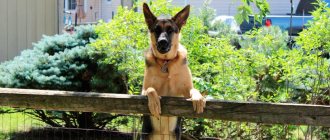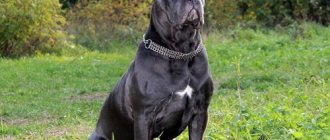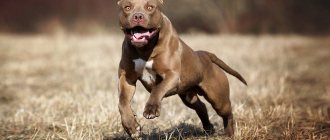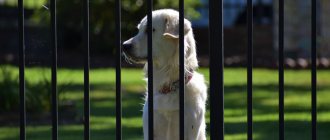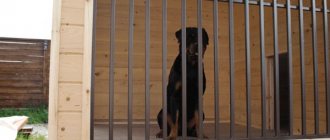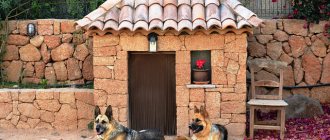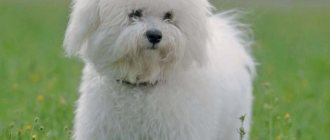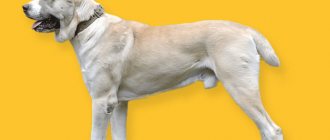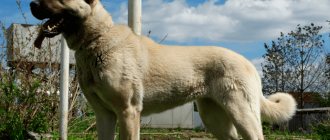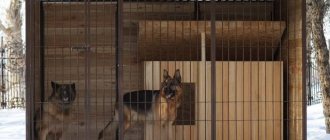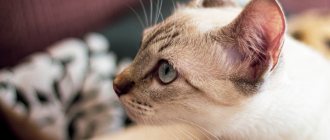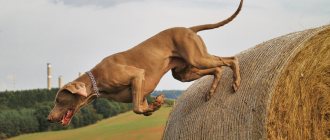For owners of country houses and garden plots, the question is very relevant: which dog to choose as a reliable guard for their home and its inhabitants. The ideal watchman should have a large or medium athletic build, a pronounced territorial instinct, a tough character, developed intelligence, independence, fearlessness, endurance, be well trained, distrustful of strangers, unpretentious in maintenance and resistant to weather changes.
A good watchdog must first of all warn its owners about the threat, and only then boldly attack the ill-wisher. At the same time, even having a set of necessary qualities, any breed of guard dog needs comprehensive education, professional training and physical activity. As a result of our analysis of sites and forums dedicated to dog breeding, we have compiled the TOP 20 best dogs for guarding a private home.
Caucasian Shepherd Dog
According to many experts, this is one of the bright favorites among guard breeds. The animal is distinguished by its formidable appearance, incredible strength, independent character and qualities such as fearlessness, courage, determination and perseverance.
The Caucasian Shepherd is loyal to its owners, incredibly smart, easy to train, unpretentious in maintenance and ideal for protecting the local area. In critical situations, she does not show concern, makes independent decisions and attacks uninvited guests without warning. For comfortable keeping, this dog must be provided with a covered outdoor enclosure and space to run.
What dog breeds are suitable for children with allergies?
Be sure to check out the list of four-legged friends for allergy sufferers. Although hypoallergenic, the breeds listed below have completely different personalities and sizes.
Basenji
The Basenji cannot bark, practically does not smell like a dog, and is famous for its cleanliness. Due to the lack of undercoat and low shedding, it is classified as conditionally hypoallergenic. That is, it can cause allergies, but much less often than other dogs.
Komondor (Hungarian Shepherd)
The corded coat of Komondors does not cause allergies and does not require complex care. These four-legged animals are extremely loyal to children, but only to acquaintances. They are suspicious of others due to their pastoral background.
Bolonki
Maltese (Maltese) and Bichon Frize (French) hardly shed and do not have a specific dog smell. Both dogs are famous for their mischief and energy. The main difference between these breeds is the extraordinary jealousy of Maltese dogs.
Chinese Crested
These four-legged animals are hairless and downy, but both are hypoallergenic. Chinese Cresteds idolize their owners and cannot stand being alone. Without regular communication, they go crazy and fill the whole house with a loud howl.
Italian Greyhound
The Italian Greyhound is an unusually gentle dog, reminiscent of a cat in its habits. She loves to rest on any horizontal elevations and hates water. Due to its low shedding and smooth coat, it is classified as conditionally hypoallergenic.
Samoyed
Like the long-haired Maltese, the Samoyed is notable for its luxurious snow-white coat. He rarely sheds, does not smell like a dog and is not prone to dandruff. Samoyed wool has water-repellent properties and a self-cleaning function. Thanks to this, it not only does not cause allergies, but also does not require complex care.
Central Asian Shepherd (Alabai)
A very powerful defender and reliable guard of any objects with pronounced territorial behavior. Representatives of this ancient breed are not distinguished by a strong emotional attachment to humans, are unpretentious and are accustomed to survive in harsh conditions.
Alabais are devoted to their owners, balanced, independent, always strive to control the environment, are aggressive towards other people's dogs and in difficult situations warn about themselves with a loud growl. Being first-class guards, they are willful and disobedient “students”, so work on their education should begin from puppyhood.
Breed overview
Pets cause not only joy, but also trouble. Easy to care for and maintain, breeds require less attention from their owners in everyday matters.
The most unpretentious representatives of the breeds in food will not require any special financial costs for maintenance.
Some dogs can easily tolerate walks once a day or no walks at all. All this should be taken into account when choosing a pet.
Little ones
Small dogs can live well in a small apartment. They need less space to run and play. Let's take a look at these interesting breeds of unpretentious dogs.
Belgian Griffon
Dogs reach a weight of up to 5 kg and are classified as decorative. Representatives of the breed live for about 15 years. A dog with a beautiful beard has an easy-going disposition and a quick learner. The peculiarity of care lies in the fur on the face - it should be cleaned and combed after eating.
The only weak points in terms of health are the eyes and skin, and the immune system is generally good.
Walks can be 2 times or 1 time for 20 minutes or 1 hour, respectively. Representatives of the breed get along well with other animals.
Papillon
The exquisite long hair of the representatives of the breed does not emit an unpleasant dog odor and practically does not change seasonally. Dogs grow up to weigh up to 4 kg. There are no allergic reactions to representatives of the breed; they get along well with small children. Pets are smart and quick-witted, they understand the words of their owners.
Moscow watchdog
This young domestic breed is a worthy option for guarding a country house. It is characterized by innate guard qualities, a terrifying appearance, huge size, strong structure, good trainability and controllability.
The Moscow Watchdog is a devoted, sociable, balanced and independent dog with fearlessness, perseverance, and the desire to protect household members and the entrusted object. The favorite military tactic of the “Muscovite”: let everyone in, don’t let anyone out. Thanks to its unpretentiousness, long hair and thick undercoat, this formidable guard can effectively guard a large territory and patrol the perimeter in harsh climatic conditions.
Large breeds of dogs for guarding a private home
Traditionally, territory protection is carried out by large, powerful dogs, historically bred specifically for these purposes. The innate ability to store and protect the master's goods is the most important psychological factor of the working breed and is passed on from generation to generation. A distinctive feature of all guard dogs is self-confidence and the ability to make independent decisions. When faced with a stranger for the first time, a young dog with an active defensive instinct is able to effectively prevent theft and attack.
Central Asian Shepherd Dog (CAO)
Despite having the word “shepherd” in its name, the CAO does not have the herding instincts of the Australian, Scottish, Hungarian or Border Collie. The original purpose of the “Asians” for centuries was to protect the herd and the owner’s home from predators and two-legged ill-wishers. The ability to survive in the natural environment with minimal care from the owner has hardened the breed, endowing its representatives with the qualities of a stern warrior and giving them the formidable nickname - “wolfhound”.
There are several types of CAO, differing phenotypically and historically tied to a particular area. Thus, the Turkmens call their wolfhounds “alabai”, the Uzbeks – “buribasar”, the Kazakhs – “tobet”, considering them a national treasure and pride. At the same time, all purebred SAO workers and their descendants, not spoiled by show breeding, are distinguished by a pronounced territorial instinct, independent character and desire to win in a fight. These formidable dogs do not have a strong emotional attachment and dependence on humans, like the German Shepherd, which is why they are the best dogs for guarding a private home.
Outwardly, the “Asian” is calm, but always vigilant, controls the situation and does not voice his voice without reason. Any person or animal who unauthorizedly enters the territory entrusted to the CAO will be attacked and severely punished. Increased aggressiveness, enormous combat potential and physical strength can create difficulties even in communicating with the owner and his family, therefore, for comfortable living in the same yard with the CAO, skillful handling of the dog and obedience training from puppyhood is required.
Caucasian Shepherd Dog
The Caucasian Shepherd Dog is an ancient breed, used for several thousand years to protect property and protect herds from wolves. The herding instinct is not expressed, but the protective and guard qualities are honed by natural selection and directed selection. According to one version, the “Caucasians” descended from the progenitor of the Molo group - the Tibetan Great Dane, and according to another, their ancestors guarded the cities of the Urartu-Ararat kingdom.
Soviet dog handlers placed emphasis on the working use of the breed and the development of such useful qualities as physical strength, unpretentiousness to living conditions, fearlessness and increased aggressiveness. For guard purposes, dogs with thick, elongated hair, impermeable to precipitation, and capable of doing without shelter and sleeping in the snow, have become widespread. In addition, there are short-haired Caucasian Shepherds and individuals with an intermediate coat type.
Mistrust, lack of fear and tirelessness in guard duty make Caucasian wolfhounds ideal dogs for guarding the yard. In any weather and at any time of the day, these dogs are “at work”, sensitively recording and preparing to stop any potential threat. The “Caucasian” is incorruptible and considers an enemy even a person whom he has seen more than once. He cannot be frightened by loud screams or even strong blows, so a fight with a wolfhound, which has a habit of attacking the face and throat, is mortally dangerous.
The most important point in keeping the breed is the correct upbringing of the puppy and the early setting of priorities, since a huge and wayward dog will only obey the person he respects. As they grow older, self-will and aggressiveness in character intensify, which is especially true for male dogs, which sometimes exceed a hundredweight in weight.
Black Russian Terrier (RCHT)
This breed is the pearl of Soviet cynology, born in the Krasnaya Zvezda kennel based on the fusion of such breeds as the Giant Schnauzer, Rottweiler, Newfoundland, Airedale Terrier and others. The main task of the breeders fulfilling the official government order was to create a well-trained service and guard dog capable of working in difficult climatic conditions. As a result, the entire psychophysiological appearance of the RCT turned out to be “tailored” to high functionality: thick, long hair as protection from frost; wide shaggy paws so as not to fall into the snow; energy and long limbs for running and jumping, large stature, great physical strength and powerful jaws for victory in single combats with a two-legged opponent. In the 80s of the twentieth century. “Blackies” received a great response, conquering the most prestigious exhibitions at the international level.
Unlike individual wolfhounds, RCT is loyal to its owner, intelligent and capable of succeeding in all types of service training. At the same time, “Stalin’s dogs” have an innate distrust of strangers and a strong territorial instinct, which allows them to be used as excellent guards. Its spectacular nickname “black lightning” speaks about the swiftness, tirelessness and power of RCT attacks.
When purchasing a “blackie” as a dog to guard a private home, you should remember that this is not a primitive “chain dog”, but an intelligent animal that requires serious work and constant communication with humans. For the health and presentable appearance of the dog, a chic black “fur coat” in spring and summer requires special care.
Moscow watchdog
The breed was bred in the mid-twentieth century. cynologists of the Krasnaya Zvezda kennel by crossing a Caucasian Shepherd Dog and a St. Bernard with an influx of blood from a Russian Pinto Hound. The resulting dogs were distinguished from the viciously capricious “Caucasian” by their controllability and good trainability, and from the constitutionally raw and sedentary St. Bernard – by the strength of their ligaments and the strength of their structure. At the same time, the “Muscovites” steadfastly passed on to their descendants their unpretentiousness to living conditions, resilience, tall stature, bonyness and innate watchdog qualities. The long, shaggy coat and thick undercoat provide frost resistance and readiness to serve in harsh winter conditions.
The Moscow watchdog will be able to reveal its talent over a large territory, patrolling the perimeter, sensitively monitoring the inviolability of borders and punishing intruders. Despite its impressive dimensions, the Muscovite is quite agile, but will not make noise or be overly aggressive without reason. However, if danger is detected, the dog will work viscously and energetically, accompanying the attack with a deep, rough bark. This breed has an innate “military tactic”: let everyone into the yard, but do not let anyone out on pain of death.
Rottweiler
This is an ancient breed of the Molosian group, tracing its history back to Roman cattle dogs and Assyrian fighting dogs. The name “Rottweiler metzgerhuhd” - “Rottweiler butcher’s dog” is associated with the city of Rottweil in the Württemberg region, and German butchers used the guard qualities of the breed by hanging a purse with the proceeds around the neck of incorruptible guards before going to get drunk in a tavern.
The modern Rottweiler combines the excellent qualities of a universal working dog, while being distinguished by heroic strength, innate nobility, balanced character and incredible affection for the owner. Representatives of the breed do not tolerate a change of owner, whom they once sincerely loved and recognized as the “leader of the pack.” Rottweilers work in full gear, attack powerfully and swiftly, knocking them down and grabbing them with their mouths full. To educate them, you need a strong but fair hand and a subtle understanding with a person. The Rottweiler is by no means a “chain dog” and is not an option for isolated keeping. A rational home arrangement for this dog is a good-quality enclosure with a roof and an insulated booth, preferably with a built-in heater.
With the right approach, a “butcher’s dog” can be turned into an excellent bodyguard, a vigilant watchman and an excellent companion. Thanks to its strong psyche, spectacular appearance, straightforwardness, self-sufficiency and masculinity, the Rottweiler won the hearts of professional dog handlers, who coined the saying: “If you trained a German Shepherd, you did nothing, but if you trained a Rottweiler, you did a lot.”
German Shepherd
The “father” of the breed is Max von Stefanitz, who set the goal of breeding an easily trained service dog, tireless in work and unquestioningly submissive to a person. Energy, courage, excellent trainability and an innate interest in work perfectly characterize the German Shepherd, making it a classic of cynology.
A trained “German” can be compared to a good soldier, ready to carry out received orders always and everywhere. The execution of commands is brought to automaticity, which is undoubtedly valuable when working together with a person, but can affect the effectiveness of solo work. The human dependence of the German Shepherd requires careful study of training situations, during which the dog must learn to make decisions independently and act at its own discretion. An experienced dog handler will be able to teach the agile and jumping “German” several methods of attacking a person, including “dancing” and “twirling.”
Another distinctive feature of the breed is increased emotionality and the habit of voicing in response to a particular stimulus. Well-developed outer coat and heat-retaining undercoat make it possible to keep such a dog outdoors if there is an enclosure and recommend it for guarding a private home.
German Shepherd
A versatile, easy to train breed with a balanced psyche, excellent reactions, the ability to protect and work in a team. Energetic, quick-witted, hardy, courageous and unpretentious, German Shepherds are widely used in service, search and security activities.
They are loyal friends, love contact with family members, are loyal to other animals, are very active, emotional, and require attention and regular exercise. They treat strangers with suspicion and prefer to keep them under close surveillance. Thanks to their well-developed coat, “Germans” can be kept in an outdoor enclosure and used to protect the local area.
Read Top 20 most expensive dogs - for the price of a good car
When is it better not to get a dog?
Among small breeds, papillons and toy terriers can display dangerous aggression towards children. The Japanese Shiba Inu requires special attention and is prone to jealousy of the owner towards the child, which causes corresponding behavior. Among the service dogs that are not for children, boxers and Rottweilers stand out. Huskies are highly emotional and can be stubborn. They stop listening to children. During active games, fox terriers and jagd terriers can become dangerous. If you have children, you should not have fighting breeds - pit bulls, bull terriers and staff dogs, as well as mastiffs and wolf dogs. Caution is required when having a Shar Pei. Their stubbornness can lead to bites.
A dog is, of course, a devoted friend of a person, but sometimes it is not recommended to have one. The following main reasons can be identified:
- Unwillingness to change your habits and lifestyle. A dog requires you to make some changes to your daily routine.
- Lack of adequate care for your pet. Intermittent stay at home (long absence).
- A dog requires certain additional expenses, and the owner should have this opportunity. A hungry dog will not become a true friend.
- Neighbors' consent to barking in your yard. Frequent complaints will ruin your relationship with them.
- Consent of all family members and their kind attitude towards animals.
- Absence of insurmountable fear in children. This feeling occurs in a child if he has previously been attacked by a dog. This psychological barrier is very difficult to overcome.
- Any family member has allergies.
The most important thing is that you cannot get a dog if the owner himself is not mentally prepared for it. He must sincerely love the animal and pass this feeling on to his children.
In a private home, having a dog often becomes a necessity. There are many breeds that provide reliable protection and become a friend and protector for the child.
Tibetan mastiff
An ancient breed, specially bred for protection in the harsh climatic conditions of the Himalayan mountains. The Tibetan Mastiff is quite balanced, not prone to excessive aggressiveness, but is extremely distrustful of strangers and is capable of frightening just by its appearance.
He is tall, athletic, with a large head, powerful paws, long hair and a thick mane, which makes him look like a lion. The breed is distinguished by intelligence, stubbornness, independence, cleanliness, unpretentiousness in maintenance and loyalty to animals.
The mastiff tends to constantly monitor the entrusted territory, loudly warns approaching strangers about itself and immediately attacks if the protected perimeter is violated.
Medium breed guard dogs
Medium-sized guard dogs are a real compromise. They take up less space, eat less, and don't look as rugged as larger dogs, but are less fussy, command more "respect" and keep strangers away, unlike smaller guard dogs. Medium breeds of guard dogs can live in both apartments and houses.
Giant Schnauzer
The Giant Schnauzer is a real bundle of energy. With an active person it will be easy and comfortable for him, but with a homebody he will get bored and begin to feel sad. At the same time, he senses the owner’s mood well and never gets bored. Gets along well with children.
Giant Schnauzers have innate guarding instincts. They work on protective guard duty. A huge reserve of patience makes dogs attentive and sensitive watchdogs. They are ready to protect from danger even at the cost of their lives.
Weight – up to 70 kilograms, height – 45-47 centimeters. The body is large, strong, but compact.
American Staffordshire Terrier
Among guard dogs for a medium-sized private home, Staffords are distinguished by their warlike disposition, intelligence and loyalty. They are ready to fight to the end for their owner. Their fighting qualities are better developed than their guard qualities, but they warn the owner of the approach of a stranger and faithfully defend the territory.
Staffords are compact: they weigh 25-30 kilograms, their height is 45-48 centimeters - they take root well even in an apartment. Powerful, strong, agile.
They respond well to training. If the owner pays enough attention to the dog, the dog will learn to understand perfectly. Education requires patience and respect; rudeness and physical strength will make the dog unsociable.
Miniature Schnauzer
Miniature Schnauzers are natural searchers and watchdogs with a keen sense of smell. They are leaders by nature, so the owner must remind them who is boss in the house. They treat strangers with suspicion and distrust, and react emotionally to family members, often showing their affection.
Giant Schnauzers have a light, compact body. Weight – 20-25 kilograms, height – 45-50 centimeters. They need active games and long walks. During the training process, dogs easily lose interest and begin to cheat. Their mind needs to be constantly stimulated in order for the dog to do what he wants.
Bull Terrier
Bull Terriers are bred as guard dogs due to their menacing appearance. However, with proper upbringing, they grow up to be friendly and loyal. They rarely show aggression even towards strangers; they scare away with their appearance, not with their barking. Some, wanting to get an ideal guard, raise a dog by force, but this is wrong - the dog will become uncontrollable and will attack even its own people.
Bull Terriers grow up to 55 centimeters and weigh 30 kilograms. Overly active. Need constant physical activity. Without them, they will begin to spoil things and grumble at the owner in order to throw out the accumulated energy.
Appenzeller Mountain Dog
Appenzeller Mountain Dogs are strong and agile. The body appears compact. Height – 58 centimeters, weight – 27 kilograms. At a young age they are overly temperamental, so they need education.
By nature, Mountain Dogs are working dogs that are ready to faithfully serve humans. They are loyal, love to feel needed and be useful. Smart and inquisitive by nature.
They show suspicion and wariness towards strangers. They will show aggression only when there is a threat. To develop protective qualities, you need to socialize the puppy and start training it as early as possible.
Chow chow
Photo from Wikipedia website
This is one of the oldest breeds. She was originally bred for security and protection. Massive body, large head, wide back. Due to their fluffy fur, Chow Chows appear even larger. She needs careful care: combing and regular washing. Height is 50-56 centimeters, weight is 30-33 kilograms.
They are loyal to humans and show virtually no aggression. They are suspicious of strangers. They can be stubborn and overly independent. They learn hard, but they memorize commands quickly. Chow Chows are more suitable for apartment life, as they are not too active. Maintenance does not require long walks. Prone to laziness.
Shar Pei
Shar Peis are watchmen, shepherds, protectors and fighters. They need a strong owner who will become an authority. They need early socialization, without this they will grow up aggressive towards all people and animals. Well developed guard instincts. They instantly react to strangers and defend the territory to the end.
They weigh 35 kilograms, height at the withers is 50 centimeters. The body is muscular and strong. The paws are slender and strong. Please note that Shar Pei fur is a strong allergen. Before buying a puppy, check your body for reactions. Talk to your pet and only then make a purchasing decision.
Welsh Corgi Cardigan
This is a small shepherd dog with a long but strong body and strong legs. Height – 30 centimeters, weight – 15 kilograms. Despite their small size, Welshies are active and nimble dogs that need constant activity. They love to attract the attention of their owner and make him laugh.
The character is calm, good-natured, with a touch of phlegmatism. They get along well with people of all ages and with animals. Unlike their fellow Pembrokes, they do not trust strangers and often bark at them. But the rest of the time they are quiet and well-mannered. They make noise only when there are good reasons, such as the invasion of strangers.
Airedale
Airedale Terriers are hunters. They cannot stand loneliness and begin to damage things without attention. They love to chase small animals, but if they grew up with them from childhood, they become friends. Airedale Terriers are owners. They will protect and snap at anyone who encroaches on their property - toys and bones or home, owner. They are jealous of other animals, and the neighborhood can be unpleasant for them.
Airedales weigh 20 kilograms and are 60 centimeters tall at the withers. Health is good if you let your dog expel energy. Without load, they degrade and fall into apathy, often getting sick. They maintain a cheerful disposition throughout their lives.
Boxer
This is a large breed of dog with strong paws. Boxers weigh up to 30 kilograms and grow up to 60 centimeters. They are loyal, obedient and calm. They love family members and get along well with children. They are easy to learn and remember commands the first time. If they break the rules, it is only to attract the attention of the owner.
Boxers are used as guards, detectives, watchmen, guides and companions. They are distrustful of strangers and are ready to do anything to protect their family. Families are the ones who are not so attentive to the house. They love to be useful and are happy to fulfill human demands.
Rottweiler
A universal breed of service dog bred in Germany, characterized by endurance, energy, hard work, aggressiveness and excellent guard qualities.
Rottweilers are recognized by their spectacular appearance, heroic strength, innate nobility, balanced character and incredible affection for the owner. They make attentive bodyguards and vigilant watchmen. In unusual situations, they prefer to wait a little before making a decision. They enter the fight with a swift throw, powerfully attack, knock them down and grab them with their entire mouth.
These dogs are stubborn and tend to claim leadership, so special attention should be paid to their early education. A well-developed undercoat allows them to be used to protect personal territory.
Small breeds of dogs for guarding a private home
Traditionally it is believed that a guard dog should be intimidatingly huge. However, small dogs for home protection do an excellent job, but it is important to choose the right breed. The main requirement for him is a bright, angry temperament, quick reaction and distrust of strangers. All these qualities must be firmly fixed genetically, so you need to choose a candidate for a guard from the working lines.
German Jagdterrier
An unsightly, lean Jagdterrier weighing only about 10 kg is a hurricane of inexhaustible energy, lightning-fast rush and anger. Courage, passion for work and a tenacious grip, cultivated over decades, allowed the breed to take a leading position in the list of hunting dogs. Jagdas work well against burrowing animals, have a keen sense of land and are fearless of the water elements. Their jaws are capable of tightly squeezing the throat of a fox or badger and tearing the tendons on the leg of a wild boar. Jumping ability and agility allow you to dodge counterattacks, and a high pain threshold allows you to continue the attack until the enemy is completely exhausted. It is not uncommon for a pair of yagterriers to deal with a powerful, heavy dog in a few minutes, disoriented by the attacks of small black and tan demons. Accordingly, keeping poultry and animals in the same yard as such a dog will be very problematic.
The difference in size and attempts to resist inflame the dog even more, so that after removing the psychological barrier, the yagd will attack the two-legged enemy with no less pressure and fury, hanging on him with a clothespin, jumping away and inflicting multiple lacerations.
Wirehaired dachshund
Due to their unangelic nature, even domestic dogs become family tyrants, and working lines are characterized by an uncontrollable desire to go into battle, regardless of the circumstances. These short-legged “sausages” have long fangs and a strong grip, and their choleric and vicious nature is complemented by a loud voice and a keen sense of smell. They fearlessly dive into a dark animal hole, strangle the animal and, backing away, pull it out to the hunter.
Raised in relative isolation, Dachshunds will become incorruptible and sensitive watchdogs. For living in “Spartan” conditions, a standard wire-haired variety (height up to 35 cm and weight 7-9 kg) with a relatively dense “fur coat” is best suited. When breeding this breed to enhance aggressiveness, the blood of other small, wire-haired dogs with an active defensive reaction was selectively infused. Dachshunds cannot jump high, like terriers, but they will stubbornly and daringly work “downstairs”, grabbing a person’s legs, wagging and tearing clothes. Keeping them with other animals is problematic.
Miniature Schnauzer
The smallest schnauzer has inherited all the characteristics of the glorious family of “barbel-beards”, which were once called “stable pinschers”, guarding horses and having a reputation for being notorious rat catchers. From their ancestors, mini-schnauzers inherited vigilance, fearlessness, ingenuity and developed protective instincts. Tatyana Filippova, breeder and FCI expert, called them “giant schnauzers in a tablet.”
Miniature dogs can be easily trained in most dog professions, and in particular in protecting territory, if from childhood they develop distrust of strangers, a deep grip and a desire to fight with humans. Despite their small size, mini-schnauzers are jumping and agile, so they are able to attack and bite an opponent not only on the legs, but also on the groin, side and arms. For the winter, these dogs grow well, and their good health and unpretentiousness in food make their maintenance much easier.
Black Russian Terrier
These large service and guard dogs are distinguished by excellent physical characteristics, endurance, stable psyche, devotion to the owner, unpretentiousness and strong immunity.
Black terriers love to communicate with household members, are well controlled and easy to train. Security qualities are inherent in them at the genetic level: they have observation, courage, excellent reaction, excellent speed, distrust of strangers, territorial instinct, and are able to serve in unfavorable natural and climatic conditions.
Bernese Mountain Dog
Fluffy cute dogs that are often found in the leading roles of TV series or films. Dogs have truly achieved the status of the ideal family pet. They are smart, kind, affectionate, calm, a little lazy and cute.
The breed was bred in Switzerland as an assistant to shepherds. They guarded and herded livestock. Several centuries later, pets are still in service, although more often they lie on the sofa in the circle of a loving family.
- They live friendly with children and pets. They protect them from danger, protect them and care for them like a herd. The distinctive habit of dogs is to herd those around them into a group, to monitor the integrity of the team, especially during walks. They actively participate in games, although they will not go jogging or racing a bicycle.
- Long hair requires special care, at least regular combing. Walks may not be active. Sennenhunds can get along in an apartment, although it is better to keep them in a large house with a yard. They are suitable for a measured life in calm, friendly families; owners need to constantly give love to the dogs, otherwise the dogs will become sad.
Cane Corso
One of the rare, very expensive and oldest breeds of the Molosser group, bred in Italy. These are muscular, intelligent, hardy and unpretentious guards who intuitively determine the degree of danger of a given situation. Cane Corsos are characterized by good manners, patience, and love for children and animals. They do not have a tendency to causeless aggression, but when a threat to the safety of the owner or a protected object arises, they make independent decisions and react in a timely manner.
The owner must have leadership qualities, as these dogs are characterized by stubbornness, reactivity and extreme mobility. Suitable outdoor conditions: a spacious indoor enclosure with a warm booth and long walks in the yard.
Equipment and ammunition
Arranging the life of a four-legged pet will require some material and labor investments. For a dog to be comfortable in the yard, it needs an enclosure and/or a kennel. To walk your dog outside of private territory, visit a veterinary clinic, exhibitions and other public places, you must purchase appropriate equipment.
Aviary
An aviary is a room fenced with two, often three, blank walls and a net. The dog inside is off-leash.
The enclosure is equipped with a plank floor, eliminating the possibility of undermining. A canopy that completely or partially covers the fenced area will protect from bad weather. A full-size door is equipped in one of the walls, equipped with a strong bolt and opening inward. A booth is installed in the enclosure.
The minimum dimensions of the enclosure are selected in accordance with the height of the dog at the withers:
- 50 cm - from 6 m2;
- from 50 to 65 cm - at least 8 m2;
- above 65 cm - from 10 m2 or more.
Regardless of the area, the width of the enclosure cannot be less than 2 m.
The following materials are chosen for the construction of the premises::
- wooden boards for walls and floors;
- chain-link mesh with polymer coating or galvanized;
- ondulin, slate or other roofing material for a canopy.
The most durable design will not allow the pet to get out , but will not limit its active pastime.
Below is an educational video on how to properly create conditions for a German Shepherd to live in an enclosure:
Booth
The booth will protect the shepherd from heat, cold, precipitation and scorching sun. The following describes what size booth is recommended. In order for the dog to feel comfortable in the kennel, the dimensions of the dog house should be as follows:
- depth is 10 cm greater than the length of the animal;
- height not less than the height of the dog to the tips of the ears;
- width equals height + 10 cm;
- hole - 35x50 cm.
In a booth that is too spacious, your pet will not be able to stay warm in winter; in a small one, it will be cramped.
It is preferable to have a pitched roof with a slight slope of up to 15° , since dogs love to sit and lie on the kennel, observing their surroundings. An extended canopy over the opening will protect the entrance from snow and rain.
The winter hut is insulated by making double walls, floor and roof. Thermal insulation material is laid between the skins - mineral wool, polyurethane foam, etc.
In winter, the hole is covered with a tarpaulin curtain. If you make the roof liftable, it will be easier to clean the kennel.
And yet, for such a large dog, preference should still be given to alternative options for “living” the pet on the street .
We invite you to watch a video about setting up a doghouse for a German Shepherd with your own hands:
Leash
For the convenience of both the owner and the pet, at least two leashes are purchased. One long one - 3-8 m - for walking in designated areas where you can loosen the leash to its full length. Another short one - 100 cm - for being in public places.
Types of leashes for German Shepherds:
- canvas;
- lavsan braid;
- leather;
- "roulette";
- "driver".
The owner chooses a leash based on the financial capabilities and convenience of himself and the dog.
Collar
The collar for the German Shepherd is selected by size and type:
- traditional leather products, canvas or mylar braid - these are “soft” collars adjustable in length for everyday walks;
- “strict” metal collar - parfors;
- noose chain.
The last two types are used to correct the dog's behavior.
The average collar size for a representative of the breed is ML 45–55 cm.
Muzzle
A muzzle is necessary even if the pet, according to the owner, “does not bite.” According to the Law “On the Maintenance of Animals”, in a public place a service breed dog must be muzzled and on a short leash. Aggressive dogs are required to wear a muzzle to ensure the safety of others.
Types of muzzles for German Shepherd:
- leather - solid and open;
- metal grid;
- plastic;
- nylon, or medical, intended for visiting a veterinarian.
A properly sized muzzle will not cause discomfort to your pet. If it is not possible to buy a muzzle with fitting, find out the following muzzle sizes in advance:
- Girth _ Measured 1 cm below the eye line. Add 3–7 cm to the resulting figure.
- Length . Distance from the tip of the nose to the muzzle circumference line.
The strap securing the muzzle to the back of the head has an adjustable length.
Important : a muzzle is not always an accessory for an aggressive dog; a muzzle will prevent the pet from picking up poison from the ground, for example, thrown by a dog hunter.
Below is an interesting video about how to choose the right muzzle for a German Shepherd:
Boerboel
African breed of working dogs with excellent watchdog qualities. They belong to an ancient family of mastiff-like animals and are distinguished by their impressive size, muscular build, endurance, good speed, agility, instant reaction and the ability to quickly assess the situation.
Boerboels are not prone to excessive malice and unmotivated aggression, they treat children well and are loyal to other animals. At the same time, these dogs are independent, stubborn, strive for dominance and are extremely active, so they need a leader owner, quality training and space for physical activity.
Read TOP 20 kindest dogs in the world
Border Collie
This breed is considered the smartest in the world, which makes it ideal for training, training work, participation in exhibitions, programs, and sports competitions. On the other hand, Collies are often cunning, manipulative, and like to regulate the lives of their household members and “guide” them.
The dogs are herding dogs and still remain working dogs. They got excellent physical abilities: speed, agility, endurance. Their owners must be prepared for constant activity. Pets vitally need physical and mental exercise.
Border collies are not aggressive and cannot serve as guards because they are not suspicious of strangers. They love pets and children and are always around. Experts advise bringing such an animal into families with older children (6-7 years old). Although if you need a good nanny, these dogs will do an excellent job. They will take you out of the burning house, pull you out of the pool, and take away the knife.
- Collie training is a pleasure. Pets quickly understand and remember commands, carry them out without stubbornness or evasiveness. Scientists have proven that their intelligence level is approximately equal to that of a three-year-old child.
- It is impossible to say with certainty that the breed is suitable for everyone. She needs serious physical activity and constant training. The ideal pet will be for young active families without children or with older children. However, you need to be prepared for constant harassment and surveillance.
- Dogs must be kept outside the city, in a private house with a large surrounding area. In urban conditions, the animal will feel uncomfortable, although it can get used to it with proper early socialization.
Doberman
A popular German breed of service dogs, quite suitable for guarding private property. Dobermans are characterized by an elegant appearance, devotion to their owner, they have good physical characteristics, a balanced character, intelligence, a stable psyche, fearlessness, are easily trained and moderately aggressive.
When a threat arises to family members or a protected object, they instantly rush at the intruders and fight to the end, not sparing their lives. These dogs require a steady hand, training and exercise to build their stamina. Short hair and a slight layer of fat do not allow Dobermans to be kept outside when cold weather sets in.
For apartment
Little ones
Decorative small dog, weighing up to 5 kg, with a relatively high life expectancy - 15 years. Playful, obedient, easy to train and funny dog with a characteristic beard. After eating, it will have to be cleaned and periodically combed, but otherwise caring for the dog is simple.
My health is excellent, although I may have problems with my eyes and skin. You can walk with the griffin only once, for about an hour, or you can take it out twice a day for 20 minutes. Gets along well with other pets. This is the easiest small dog to care for.
An incredibly beautiful (weighing up to 4 kg) small breed dog with exquisite long hair. It was once the pride of French kings, but today it can bring joy to any apartment.
Despite the thick coat, the Papillon does not need to be carefully looked after: it has almost no seasonal shedding, as well as the smell of a dog. Moreover, he is hypoallergenic, highly intelligent and very affectionate with children - an ideal dog!
This is an exotic dwarf (weighing 7 kg) dog from the island of Madagascar with a stunning white coat. The white thick fur does not shed and does not cause allergies, so there will be no special problems with caring for it. Moreover, the Coton de Tulear is considered a very healthy dog - according to statistics, only one puppy out of 100 has a risk of getting a hereditary disease.
Real shaggy cloud
